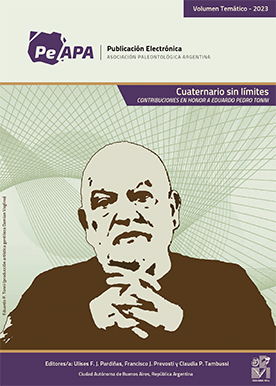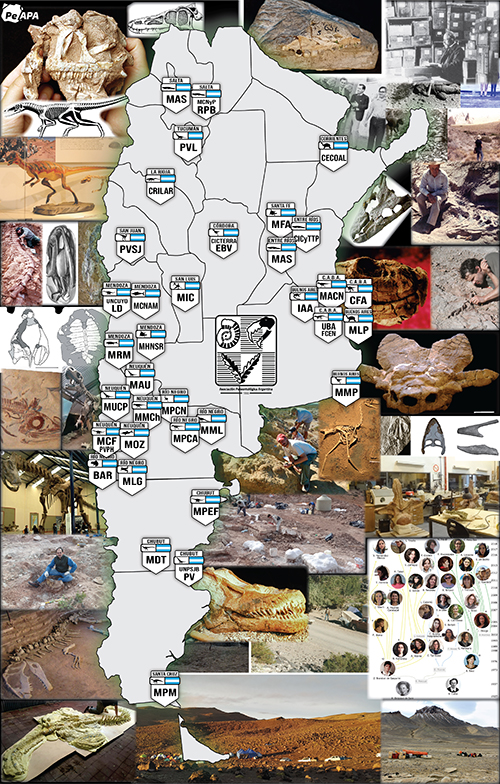REGISTRO PALEOBOTÁNICO DEL PLIO–PLEISTOCENO INFERIOR EN EL VALLE DEL RÍO URUGUAY. CARACTERIZACIÓN FITOLÍTICA DE LA FORMACIÓN SAN SALVADOR, ESTE DE LA PROVINCIA DE ENTRE RÍOS, ARGENTINA.
DOI:
https://doi.org/10.5710/PEAPA.29.06.2021.383Palabras clave:
Fitolitos, Formación San Salvador, Valle del Río Uruguay, Plio–Pleistoceno InferiorResumen
La Formación San Salvador es uno de los pocos depósitos del Plioceno–Pleistoceno Inferior en el este de la provincia de Entre Ríos, que desde el punto de vista paleontológico ha sido descripta mediante su contenido fitolítico exclusivamente. La presente contribución comprende la síntesis y ampliación de estos conocimientos mediante la incorporación de los resultados del estudio fitolítico del perfil José Etchepare Hijo (Departamento Colón, Entre Ríos) a los ya descriptos. Para ello se ha utilizado una metodología ad-hoc, adaptada para la obtención de fitolitos en depósitos fluviales. Las secuencias sedimentarias se caracterizaron por presentar una sucesión de estratos de conglomerados matriz soportados, facies arenosas finas a gruesas y facies finas (representadas por arcillas y limos). Los resultados permitieron observar mayor abundancia de fitolitos y diversidad en estratos de textura arenosa; y proporcionalmente más escasos y hasta ausentes en los estratos de textura gravosa principalmente. Los fitolitos no diagnósticos de gramíneas fueron comunes en el total de las muestras con microrestos, mientras que entre los de menor tamaño y diagnósticos su presencia se manifestó solo en ciertos sectores de los perfiles. Las asociaciones fitolíticas se conformaron por elementos de las familias Arecaceae, Poaceae (Bambusoideae, Panicoideae, Danthonioideae, Chloridoideae y Pooideae) y Podostemaceae; y han permitido inferir el desarrollo de paleocomunidades de bosques higrófilos estratificados, palmares y bosques en galería, que indican un clima tropical-subtropical húmedo, con gran disponibilidad hídrica.
Referencias
Alexandre, A., Meunier, J. D., Colin, F. y Koud, J. M. (1997). Plant impact on the biogeochemical cycle of silicon and related weathering processes. Geochimica et Cosmochimica Acta, 61, 677–682.
Bertoldi de Pomar, H. (1971). Ensayo de clasificación morfológica de los silicofitolitos. Ameghiniana, 8, 317–328.
Bertoldi de Pomar, H. (1972). ópalo Organógeno en Sedimentos Superficiales de la Llanura Santafesina. Ameghiniana, 9, 265–279.
Bertoldi de Pomar, H. (1975). Los silicofitolitos: Sinopsis de su conocimiento. Darwiniana, 19, 173–206.
Bertoldi de Pomar, H. y Tur, N. M. (1970). Células silicificadas en gramíneas acuáticas. Revista de la Asociación de Ciencias Naturales del Litoral, 1,17–18.
Blecker, S. W., McCulley, R. L., Chadwick, O. A., y Kelly, E. F. (2006). Biologic cycling of silica across a grassland bioclimosequence. Global Biogeochemical Cycles, 20, 1–11.
Blinnikov, S. I., Nadyozhin, D. K., Woosley, S. E. y Sorokina, E. I. (2002). En W. Hillebrandt y E. Muller, (Eds.), Nuclear Astrophysics Shock Breakouts in SNe Ib/c (pp. 144). Springer-Verlag.
Brea, M. (1998). Ulminium mucilaginosum n.sp. y Ulminium artabeae n.sp., dos leños fósiles de Lauraceae en sedimentos de la Formación El Palmar, provincia de Entre Ríos, Argentina. Ameghiniana, 35(2), 193–204.
Brea, M. (1999). Leños fósiles de Anacardiaceae y Mimosaceae de la Formación El Palmar (Pleistoceno superior), del Departamento Concordia, provincia de Entre Ríos. Ameghiniana, 36(1), 63–69.
Brea, M., Aceñolaza, P. G. y Zucol, A. F. (2001). Estudio paleoxilológico en la Formación Paraná, Entre Ríos, Argentina. Asociación Paleontológica Argentina, Publicación especial 8. 11º Simposio Argentino de Paleobotánica y Palinología (pp. 7–17). Buenos Aires.
Brea, M., Franco, M. J. y Lutz, A. I. (2012). Redescription and reassignment of Entrerrioxylon victoriensis from the Upper Miocene, Paraná Formation, South America. Review of Palaeobotany and Palynology, 185, 13–25.
Brea, M. y Zucol, A. F. (2007). Guadua zuloagae nov. sp., The first petrified Bamboo record from Ituzaingó Formation (Middle Pliocene), Paraná basin, Argentina. Annals of Botany, 100(4), 711–723.
Brea, M. y Zucol, A. F. (2011). The Paraná-Paraguay Basin: Geology and Paleoenvironments. En J. Albert y R. Reis (Eds.), Historical Biogeography of Neotropical Fresh Water Fishes (pp. 69–87). University of California Press.
Brea, M., Zucol, A. F. y Franco, M. J. (2013). A new Bambusoideae (Poaceae: Bambusoideae: Bambuseae: Guaduinae) from the Ituzaingó Formation (Pliocene–Pleistocene), Entre Ríos, Argentina. Review of Palaeobotany and Palynology, 192, 1–9.
Brea, M., Zucol, A. F. y Patterer, N. I. (2010). Fossil woods from late Pleistocene sediments from then El Palmar Formation, Uruguay Basin, Eastern Argentina. Review of Palaeobotany and Palynology, 163, 35–51.
Brunetto, E., Zucol, A. F., Schmidt, G, I., Noriega, J. I., Patterer, N. I., Brea, M. y Franco, M. J. (2019). Estratigrafía del Plioceno de la Mesopotamia argentina. En N. Nasif, G. Esteban, J. Chiesa, A. Zurita y S. Georgieff (Eds.), Mioceno al Pleistoceno del centro y norte de Argentina (Vol. 52, pp. 266–268). Opera lilloana.
Calderón, C. E. y Soderstrom, T. R. (1980). The genera of Bambusoideae (Poaceae) of the American continent: Keys and comments. Smithsonian Contributions to Botany, 44, 1–27.
Carter, J. A. (2002). Phytolith analysis and paleoenvironmental reconstruction from Lake Poukawa Core, Hawkes Bay, New Zealand. Global and Planetary Change, 33, 257–267.
Collura, L. V. y Neumann, K. (2016). Wood and bark phytoliths of West African woody plants. Quaternary International, 434, 142–159.
Delhon, C., Alexandre, A., Berger, J., Thiebault, S., Brochier, J. y Meunier, J. (2003). Phytolith assemblages as a promising tool for reconstructing Mediterranean Holocene Vegetation. Quaternary Research, 59(1), 48–60.
Ehrenberg, C. G. (1854). Mikrogeologie. Leopold Voss. Leipzig. Ferrero, B., Patterer, N. I., Brunetto, E., Ramos, S. R., Noriega, I. J., Moya, E., Peralta, M. J., Zucol, A. F., Franco, M. J y Brea, M. (2019). El registro paleontológico del Pleistoceno de la provincia de Entre Ríos (Argentina). En N. Nasif, G. Esteban, J. Chiesa, A. Zurita y S. Georgieff (Eds.), Mioceno al Pleistoceno del centro y norte de Argentina (Vol. 52, pp. 490–519). Opera lilloana.
Franco, M. J. (2009). Leños fósiles de Anacardiaceae en la Formación Ituzaingó (Plioceno), Toma Vieja, Paraná, Entre Ríos, Argentina. Ameghiniana, 46, 587–604.
Franco, M. J. (2010). Soroceaxylon entrerriensis gen. et sp. nov. (Moraceae) de la Formación Ituzaingó (Plioceno–Pleistoceno), Cuenca del Río Paraná, Argentina. Revista Mexicana de Ciencias Geológicas, 27, 508–519.
Franco, M. J. (2011). Estudios paleobotánicos de la Formación Ituzaingó (Plioceno–Pleistoceno), Cuenca del Río Paraná, Argentina. [Tesis Doctoral, Universidad Nacional de Córdoba, Córdoba].
Franco, M. J. (2012). Maderas fósiles de Lauraceae de la Formación Ituzaingó (Plioceno–Pleistoceno), cuenca del río Paraná, Argentina. Revista del Museo Argentino de Ciencias Naturales, n.s, 14, 307–324.
Franco, M. J. (2014). Estípites de Arecaceae en la Formación Ituzaingó (Plioceno-Pleistoceno), Entre Ríos, Argentina. Acta Geológica Lilloana, 26(1), 14–29.
Franco, M. J. (2017). Small Celastraceae and Polygonaceae twigs from the Upper Cenozoic (Ituzaingó Formation) of the La Plata Basin, Argentina. Historical Biology, 4, 1–15.
Franco, M. J. y Brea, M. (2008). Leños fósiles de la Formación Paraná (Mioceno medio), Toma Vieja, Paraná, Entre Ríos, Argentina: Registro de bosques secos mixtos. Ameghiniana, 45, 699–718.
Franco, M. J. y Brea, M. (2010). Microlobiusxylon paranaensis gen. nov. et sp. nov. (Fabaceae- Mimosoideae) from the PliocenePleistocene of Ituzaingó Formation, Paraná Basin Argentina. Revista Brasileira de Paleontología, 13, 103–114.
Franco, M. J. y Brea, M. (2013). Leños fósiles de leguminosas de la Formación Ituzaingó, Entre Ríos, Argentina: Implicancias paleoecológicas y paleobiogeográficas. Ameghiniana, 50(2), 167–191.
Franco, M. J. y Brea, M. (2015). First extra-Patagonian record of Podocarpaceae fossil wood in the Upper Cenozoic (Ituzaingó Formation) of Argentina. New Zealand Journal of Botany, 53, 103–116.
Franco, M. J., Moya, E., Brea, M. y Martínez Martínez, C. (2019). Astroniumxylon, Schinopsixylon, and Parametopioxylon n. gen. Fossil woods from upper Cenozoic of Argentina: taxonomic revision, new taxón and new records. Journal of Paleontology, 95, 185–201.
Fredlund, G. G. y Tieszen, L. T. (1994). Modern phytolith assemblages from the North American Great Plains. Journal Biogeography, 21, 321–335.
Hammer, Ø., Harper, D. A. T. y Ryan, P. D. (2007). PAST –Palaeontological STatistics, 1.75. 86pp.
Iriarte, J. (2006). Vegetation and climate changes since 14,810 14C yr B.P. in southeastern Uruguay and implications for the rise of early Formative societies. Quaternary Research, 65(1), 20–32.
Iriarte, J. y Paz, E. A. (2009). Phytolith analysis of selected native plants and modern soils from southeastern Uruguay and its implications for paleoenvironmental and archeological reconstruction. Quaternary International, 193(1), 99–23.
Iriondo, M. H. (1980). El cuaternario de Entre Ríos. Revista de la Asociación de Ciencias Naturales del Litoral, 11, 125–141.
Iriondo, M. H. (1996). Estratigrafía del Cuaternario de la Cuenca del río Uruguay. 13° Congreso Geológico Argentino y 3° Congreso de Exploración de Hidrocarburos, Actas, 4, (pp. 15–25). Buenos Aires.
Iriondo, M. H. y Kröhling, D. (2007). La Formación El Palmar (Informalmente Fm Salto Chico) y el Acuífero San Salvador, Entre Ríos. 5° Congreso Argentino de Hidrogeología 16–19 de octubre (pp. 433–441). Paraná, Entre Ríos, Argentina.
Iriondo, M. H. y Kröhling, D. (2008). Cambios ambientales en la cuenca del Uruguay (desde el Presente hasta dos millones de años atrás). Colección Ciencia y Técnica, Universidad Nacional del Litoral (pp. 330). Santa Fe.
Iriondo, M. H., Kröhling, D. y Bidegain, J. (2000). The Quaternary of SW Entre Ríos- Argentina. 31º International Geological Congress. Abstracts. Río de Janeiro.
Kaczorek, D., Puppe, D., Busse, J. y Sommer, M. (2019). Effects of phytolith distribution and characteristics on extractable silicon fractions in soils under different vegetation – An exploratory study on loess. Geoderma, 356, 113917.
Kondo, R., Child, C. y Atkinson, I. (1994). Opal phytoliths of New Zealand (pp. 85). Maanaki Whenua Press.
Kröhling, D. (2001). Quaternary loess-paleosol sequence of southwestern Entre Ríos Province, Northern Pampa, Argentina. 6º International Symposium and field workshop on paleopedology. Universidad Nacional Autónoma de México (pp. 27–28). México.
Lancelotti, C. (2010). Fuelling Harappan Hearths: Humane Environment Interactions as Revealed by Fuel Exploitation and Use. [Unpublished PhD Dissertation, Department of Archaeology, University of Cambridge, Cambridge].
Lu, H. y Liu, K. B. (2003). Phytolihts in common grasses in the coastal environments of southeastern USA. Estuarine, Coastal and Shelf Science, 58, 587–600.
Lu, H., Wu, N. y Nie, G. (1995). Discovery of bamboo phytolith in the loess-paleosol sequences of Guanzhong Basin, Shaanxi Province. Chinese Science Bulletin, 40(5), 405–409.
Madella, M. (1997). Phytolith analysis from the Indus Valley site of Kot Diji, Sindh, Pakistan. En A. Sinclair, E. Slater y J. Gowlett. (Eds.), Archaeological Sciences, Oxbow (pp. 294–302). Oxford. Madella, M. y Lancelotti, C. (2012). Taphonomy and phytoliths: A user manual. Quaternary International, 275, 76–83.
Madella, M., Alexandre, A. y Terry, B. (2005). International Code for Phytolith Nomenclature 1.0. Annals of Botany, 96(2), 253–360.
Meunier, J. D., Colin, F., Alarcon, C. (1999). Biogenic silica storage in soils. Geology, 27, 835–838.
Montti, L., Fernández Honaine, M., Osterrieth, M. y Graciano Ribeiro, D. (2009). Phytolith analysis of Chusquea ramosissima Lindm. (Poaceae: Bambusoideae) and associated soils. Quaternary International, 193, 80–89.
Moya, E. y Brea, M. (2015). A new record of fossil wood of Vochysiaceae from the Late Pleistocene (Arroyo Feliciano Formation), Argentina, South America. Revista Brasileira de Paleontologia, 1, 83–90.
Moya, E. y Brea, M. (2018). First Pleistocene record of fossil wood of Bignoniaceae in the Americas and a comparison with the extant Tabebuia alliance and Tecomeae. Botanical Journal of the Linnean Society, 187, 303–318.
Moya, E., Brea, M. y Franco, M. J. (2015). First record of Styracoxylon (Styracaceae) from Southern Hemisphere: Arroyo Feliciano Formation (Upper Pleistocene), Entre Ríos, Argentina. Review of Palaeobotany and Palynology, 221, 211–219.
Mulholland, S. C. (1989). Phytolith shape frequencies in North Dakota grasses: a comparison to general patterns. Journal Archaeology Science, 16, 489–511.
Nalepka, D. y Walanus, A. (2003). Data processing in pollen analysis. Acta Paleobotánica, 43, 125–134.
Neumann, K., Strömberg, C. A. E., Ball, T., Albert, R. M., Vrydagh, L. y Scott Cumming, L. (2019). International code for phytolith nomenclature (ICPN) 2.0. Annals of Botany. Oxford, 20, 1–11.
Osterrieth, M., Madella, M., Zurro, D. y Álvarez, M. F. (2009). Taphonomical aspects of silica phytoliths in the loess sediments of the Argentinean Pampas. Quaternary International, 193, 70–79.
Parr, J. F. y Sullivan, L. A. (2005). Soil carbon sequestration in phytoliths. Soil Biology and Biochemistry, 37, 117–124.
Patterer, N. I. (2010). Resultados preliminares del análisis fitolítico en facies fluviales de la Formación El Palmar (Pleistoceno Superior), en la cuenca del río Uruguay, Argentina. 10º Congreso Argentino de Paleontología y Bioestratigrafía y 7º Congreso Latinoamericano de Paleontología. (pp. 329). La Plata, Buenos Aires.
Patterer, N. I. (2012). Análisis Fitolíticos de la Formación El Palmar (Pleistoceno superior) en la cuenca del río Uruguay (Este de Argentina). [Tesis Doctoral. Universidad Nacional de Córdoba].
Patterer, N. I. (2014). Análisis fitolíticos de las principales especies de palmeras (Arecaceae) presentes en regiones subtropicales de América del Sur. Boletín. Sociedad. Argentina de Botánica, 49(4), 491–502.
Patterer, N. I. (2015). Análisis fitolíticos de la Formación San Salvador (Plioceno- Pleistoceno inferior) en la cuenca del río Uruguay, Entre Ríos, Argentina. Revista de la Asociación Geológica Argentina, 72, 332–344.
Patterer, N. I. (2017). Primer registro paleobotánico del perfil tipo de la Formación Salto Ander Egg (Pleistoceno Tardío), Sudoeste de la provincia de Entre Ríos, Argentina. Reunión de Comunicaciones de la Asociación Paleontológica Argentina. Resúmenes (pp. 61). San Luis, Argentina.
Patterer, N. I., Kröhling, D., Passeggi, E., Zucol A. F. y Brea, M. (2012). Análisis Fitolíticos en Sedimentos Fluviales Cuaternarios (Formaciones San Salvador y El Palmar) del río Uruguay, Este de Argentina. Trabajos extendidos. 3º Jornadas del Cenozoico (pp. 5). Montevideo, Uruguay.
Patterer, N. I., Passeggi, E. y Zucol, A. F. (2011). Análisis fitolíticos de suelos del sudoeste de la Provincia de Entre Ríos (Argentina) como una herramienta para comprender sus procesos pedológicos. Revista Mexicana De Ciencias Geológicas, 28(1), 132–146.
Patterer, N. I., Passeggi, E., Zucol, A. F. y Zappala, F. (2016). Técnicas de muestreo y procesamiento para la obtención de microrestos en muestras sedimentarias fluviales. Caso de estudio: Formación El Palmar. En A.F. Zucol, N.I. Patterer, M.M. Colobig y E. Moya (Eds.), Taller Micropaleoetnobotánica Relevancia de una Red Interdisciplinaria de Investigaciones en Fitolitos y Almidones. Libro de Resúmenes (pp. 31‒37).
Patterer, N. I., Zucol, A. F. y Brea, M. (2014). Análisis fitolítico del perfil sedimentario Los Loros, de la Formación El Palmar (Pleistoceno Superior), en el Parque Nacional El Palmar, Entre Ríos, Argentina. Acta Geológica Lilloana, 26(1), 53–62.
Patterer, N. I., Zucol, A. F., Fernández Pepi, M. G. y Brea, M. (2019). Plant and soil phytolith analysis of a relictual community of Butia yatay in temperate-humid savannas (Entre Ríos, Argentina). Quaternary International, 525, 126–139.
Patterer, N. I., Zucol, A. F. y Kröhling, D. M. (2020). Phytolith analysis in Quaternary fluvial deposits (El Palmar Formation- Late Pleistocene) of the Uruguay River valley, Entre Ríos province, Argentina. Journal of South American Earth Sciences, 100, 2–12.
Patterer, N. I., Zucol A. F. y Passeggi, E. (2017). Análisis fitolíticos en suelos formados sobre antiguas terrazas del Río Uruguay (Colón, Entre Ríos): primera evidencia de retracción de los palmares de Butia yatay (Mart.) Becc. Publicación Electrónica de la Asociación Paleontológica Argentina, 17(1), 1–13.
Piperno, D. R. (1988). Phytolith analysis: an archaeological and geological perspective, San Diego (pp. 280). Academic Press.
Piperno, D. R. y Pearsall, D. M. (1998). The origins of agriculture in lowland tropics, San Diego. Academic Press.
Ramos, R. S. (2014). Análisis paleoecológico preliminar de la flora de la Formación El Palmar (Pleistoceno Tardío), Entre Ríos, Argentina. Acta Geológica Lilloana, 26(1), 63–74.
Ramos, R. S., Brea, M. y Kröhling, D. M. (2012). Leños fósiles de la Formación El Palmar (Pleistoceno Tardío) en el parque Nacional El Palmar, Entre Ríos, Argentina. Ameghiniana, 49(4), 606–622.
Ramos, R. S., Brea, M. y Kröhling, D. M. (2015). Primer registro de Cryptocaryoxylon Leisman, una Lauraceae de la Formación El Palmar (Pleistoceno tardío), Entre Ríos, Argentina. Revista del Museo Argentino de Ciencias Naturales, 17(1), 59–70.
Ramos, R. S., Brea, M. y Kröhling, D. (2017a). Fossil woods of Detarioideae Subfamily (Fabaceae) from El Palmar Formation (Late Pleistocene) in South America. Journal of South American Earth Sciences, 79, 202–214.
Ramos, R. S., Brea, M. y Kröhling, D. (2017b). Malvaceous wood from the Late Pleistocene El Palmar Formation of northeastern Argentina. Review of Palaeobotany and Palynology, 246, 232–241.
Ramos, R. S., Brea, M. y Pardo, A. R. (2014). Fossil wood of Peltophoroxylon (Caesalpinioideae) from the El Palmar Formation (late Pleistocene), Argentina. IAWA Journal, 35(2), 199–212.
Reading, H. G. (1996). Sedimentary Environments: Processes, Facies and Stratigraphy. Third edition. Wiley-Blackwell. Runge, F. (1999). The opal phytolith inventory of soils in central Africa —quantities, shapes, classification, and spectra. Review Palaeobotany and Palynolinology, 107, 23–53.
Steel, R. J. y Thompson, D. B. (1983). Structures and textures in Triassic braided stream conglomerates (‘Bunter’ Pebble Beds) in the Sherwood Sandstone Group, North Staffordshire, England. Sedimentology, 30, 341–367.
Strömberg, C. A. E. (2004). Using phytolith assemblages to reconstruct the origin and spread of grass- dominated habitats in the Great Plains of North America during the late Eocene to early Miocene. Palaeogeography, Palaeoclimatology, Palaeoecology, 207(3–4), 239–275.
Tur, N. M. (1987). Podostemaceae. En N. S. Troncoso y N. M. Bacigalupo (Eds.), Fl. Il. Entre Ríos, Colección Científica Instituto Nacional de Tecnología Agropecuaria, 6(3), 43–54.
Twiss, P. C. (1992). Predicted world distribution of C3 and C4 grass phytoliths. En G. Rapp Jr y S. C. Mulholland (Eds.), Phytolith Systematics Emerging Issues: Advances in Archaelogical and Museum Science (pp. 113–128). Springer.
Twiss, P. C., Suess, E. y Smith, R. M. (1969). Morphological classification of grass phytoliths. Soil Science Society of America Proceedings, 33, 109–115.
Walanus, A. y Nalepka, D. (2000). PolPal, counting pollen, tables storage and diagrams plotting. System manual. Polish academy of Sciences, W. Szafer institute of Botany, Cracovia.
Zucol, A. F. (1992). Microfitolitos: I. Antecedentes y terminología. Ameghiniana, 29(4), 353–362.
Zucol, A. F. (1996). Microfitolitos de las Poaceae argentinas: I. Microfitolitos foliares de algunas especies del género Stipa (Stipeae: Arundinoideae), de la Provincia de Entre Ríos. Darwiniana, 34, 151–172.
Zucol, A. F. y Brea, M. (2000). Análisis fitolítico de la Formación Paraná en la Provincia de Entre Ríos. En F. G. R. Aceñolaza y R. Herbst (Eds.), El Neógeno de Argentina. Serie Correlación Geológica 14 (pp. 67–76). Argentina.
Zucol, A. F., Brea, M., Passeggi, E. y Franco, M. J. (2014). Colecciones del laboratorio de paleobotánica y procesamiento de material sedimentario del CICYTTP- Diamante (CONICET), Entre Ríos, Argentina. Boletín de la Asociación Latinoamericana de Paleobotánica y Palinología, 14, 71–82.
Zucol, A. F., Brea, M. y Scopel, A. (2005). First record of fossil Word and phytolith assemblages of the Late Pleistocene in El Palmar Nacional Park (Argentina). Journal of South American Earth Sciences, 20, 33–43.
Zucol, A. F., Passeggi, E., Brea, M., Patterer, N. I., Fernández Pepi, M. G. y Colobig, M. M. (2010). Phytolith analysis for the patrok aike lake drilling proyect: sample treatment protocols for the pasado microfossil manual. En H. Corbella y N. I. Maidana (Eds.), 1º Reunión Internodos del Proyecto Interdisciplinario Patagonia Austral y 1º Workshop Argentino del Proyecto Potrok Aike Maar Lake Sediment Archive Drilling Project, Proyecto Editorial PIPA (pp. 81–84). Buenos Aires, Argentina.
Zucol, A. F., Patterer N. I., Leiva, H., Brea M. y Passeggi, E. (2016). Caracterización fitolítica de la Formación Arroyo Feliciano (Pleistoceno Superior) en la Localidad de Paso Duarte, Entre Ríos, Argentina. Publicación electrónica de la Asociación Paleontológica Argentina (PE-APA), 16, 52–63.

Descargas
Publicado
Número
Sección
Licencia
Derechos de autor 2021 Sebastián Ariel Frezzia, Noelia Isabel Patterer, Alejandro Fabián Zucol

Esta obra está bajo una licencia internacional Creative Commons Atribución-SinDerivadas 4.0.

Los/las autores/as conservan los derechos de autor/a y garantizan a la revista el derecho de ser la primera publicación del trabajo licenciado bajo una licencia CC Attribution-NonCommercial 4.0 que permite a otros/as compartir el trabajo con el reconocimiento de la autoría y de la publicación inicial en esta revista.




















